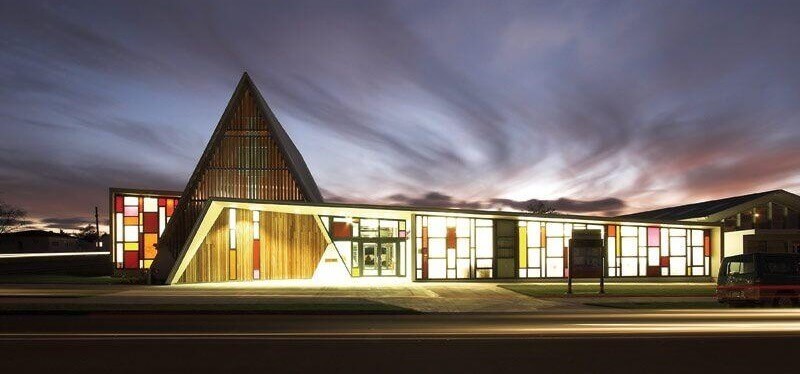Our History
- By:standrews
- Hits: 7028
Presbyterian Origins
The first Presbyterian service in Waiuku was held in Jenkins Store on 23 November 1856. The Reverend Thomas Norrie came from Papakura and preached to 80 people. In 1857 a ‘school house’ was built for meetings and worship for all Protestants. This became the foundation for the establishment of the Presbyterian Church in Waiuku, for in 1859 the Waiuku Presbyterian Station was established and in 1863 the Charge, known as Waiuku, Mauku and Districts was formed. A Mr Eccles was sent to minister to this charge under the direction of the Rev Thomas Norrie.
A church building was opened in October 1880 and until recently has been used as part of the church’s facilities. The foundation Minister was Rev Alexander Thomson and the area extended from the Waikato Heads to the Manukau Heads with an uncertain boundary to the east. This church served the community through some very testing times for over 80 years until in December 1964 a new church was opened, the minister being the Rev D R Allen.
On 1 April 2006 the current facility was formally opened by the Venerable Marilyn Welch. The existing church building was altered to include more informal seating, an adjoining hall, kitchen and toilet facilities and offices. The original church built in 1880 and the hall, were sold and transferred a site on Gleeson Road, Waipipi where they have been renovated and are used as an art studio and dwelling.
Methodist Origins
The Wesley Church is situated on a prominent site adjacent to the town centre on Queen Street. The site was purchased in 1882 from a Mr Robert Graham by the Methodist Trustees, descendents of whom are still living and worshipping in the local community. The original church built in 1866 was removed and sold to the Education Department for £60 in 1883 and taken by bullock team to a nearby settlement for use as a school.
A subscription list was commenced to raise funds for a new church even though there were only 23 active members. The new church was opened on 11th November 1883 and the liability to the Church Loan Fund finally paid off in 1890.
The Joint Venture
Many years have elapsed since the matter of combining the Methodist and Presbyterian Ministries in Waiuku and its districts was first aired. During the period to the late 1960’s, the subject came to the fore on a number of occasions, but nothing of substance eventuated.
In the 1970’s, discussions started with regard to the future of the Awhitu Presbyterian Parish, because of Presbyterian concerns as to providing ministry to such a small Parish.
In 1979 the Awhitu Presbyterian Parish was without a Minister and following discussions in early 1980, the Waiuku Methodist Minister commenced ministry in Awhitu. With a change of ministry in Waiuku in 1981, together with the pending Church Union vote, procedures were set in motion to form a Co-operating Parish, including the Waiuku Presbyterian parish. While this did not eventuate, the Waiuku Methodists and the Awhitu Presbyterians proceeded to discuss the Co-operating parish idea as this appeared to be mutually beneficial to both.
On 30 September 1984, the Franklin West Co-operating Parish came into being, with the congregations of the Co-operating Parish and St Andrews continuing to enjoy good relations and combined worship on countless occasions.
The period 1993 to early 1995 saw a number of reviews of the Franklin West Co-operating Parish and options as to its future were identified. One of those options, which had been considered in earlier years, again came to the fore, that of establishing a Co-operating parish with the Waiuku Presbyterians (St Andrews).
In April 1995, following a Ministerial Review by the Joint Regional Committee, Franklin West Co-operating Parish invited the St Andrews session to meet with them to explore options towards exploring the possibility of combining the Franklin West Co-operating Parish and the St Andrews Presbyterian Church.
Over the next two years, a series of meetings and discussions (leaders and congregations) took place, which eventuated in the setting up of a Steering Committee in July 1997 to work through the issues.
The findings of the Steering Committee were presented to a joint congregational meeting in May 1998. Following individual church discussions at a combined worship service in October 1998, agreement was gained to work towards the coming together of the two churches. An appointed Parish Council was ratified together with a management structure.
The first step in coming together was the agreement of the Wesley Church to centralise worship at St Andrews Presbyterian Church on 1 January 1999. Combined worship services have been held since this date.
The Agreement to form the Waiuku & Districts Combined Churches was signed at a service held in Waiuku on 4 August 2002.
The Pollok Church has recently been sold and all peninsula services are now held at Awhitu Central.
About Waiuku
Waiuku is the name of the place where chief Tamakae washed in the ‘wai’ (water) with ‘uku’ (soft white clay used as soap). With the arrival and settlement of European people about 140 years ago, Waiuku developed as a port and gateway to the south. It was also the terminal of the ancient Maori portage between the Waikato River and the Manukau Harbour. During the Waikato War (1863-1864) Waiuku became a frontier town guarded by a blockhouse – close to the site now occupied by the Wesley Church. As roads and rail developed, Waiuku evolved into a service town for the local farming communities.
Waiuku is situated approximately 60 km south west of Auckland (the CBD is about 45 minutes drive) on the southern side of the Manukau Harbour. The nearest large town is Pukekohe about 15 minutes west, which is the main town of the Franklin District.
The population of the area is comprised of descendants of the early settlers, New Zealanders from other parts of the country, immigrants from the British Isles, Ireland, South Africa, Europe, Korea, Indiana nd the Pacific Islands. In the last few years many people have moved from Auckland City into the area and commute daily to the city. Much of the farming area has been developed into smaller horticulture and lifestyle blocks.
In the 1960’s a steel mill was built at Glenbrook which brought new people, employment and economic activity to the district and has therefore been a major factor in the growth and development of the Waiuku area. New Zealand Steel remains the largest single employer in the area.
Waiuku is well serviced with commercial, business and medical facilities. There are three primary schools with in the urban area and 5 in the surrounding districts. All these feed a well established and successful college.


